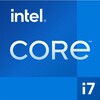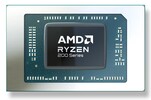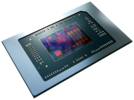Intel Core i7-1250U vs AMD Ryzen 7 260 vs AMD Ryzen 7 PRO 8840HS
Intel Core i7-1250U
► remove from comparison
The Intel Core i7-1250U is a mobile CPU for thin and light laptops based on the Alder Lake architecture. It was announced in early 2022 and offers 2 performance cores (P-cores, Golden Cove architecture) and 8 efficient cores (E-cores, Gracemont architecture). The P-cores support Hyper-Threading leading to 12 supported threads when combined with the E-cores. The clock rate ranges from 1.1 to 4.7 GHz on the performance cluster and 0.8 to 3.5 GHz on the efficient cluster. The performance of the E-cores should be similar to old Skylake cores (compare to the Core i7-6700HQ). All cores can use up to 12 MB L3 cache. Compared to the similar Core i7-1260U, the 1250U only offers "Essentials" vPro management features.
Performance
The average 1250U in our database is in the same league as the Ryzen 5 5500U; the i5-1240U, the i7-1260U and the i7-1265U are found close nearby as well.
Thanks to its decent cooling solution and a long-term CPU power limit of 23 W, the Envy x360 13-bf0013dx is among the fastest laptops built around the 1250U that we know of. It can be at least 30% faster in CPU-bound workloads than the slowest system featuring the same chip in our database, as of August 2023.
Features
The integrated memory controller supports various memory types up to DDR5-4800, DDR4-3200, LPDDR5-5200, and LPDDR4x-4267. The Thread Director (in hardware) can support the operating system to decide which thread to use on the performance or efficient cores for the best performance. For AI tasks, the CPU also integrates GNA 3.0 and DL Boost (via AVX2). Quick Sync in version 8 is the same as in the Rocket Lake CPUs and supports MPEG-2, AVC, VC-1 decode, JPEG, VP8 decode, VP9, HEVC, and AV1 decode in hardware. The CPU only supports PCIe 4.0 (x8 for a GPU and two x4 for SSDs).
The integrated graphics adapter is based on the Xe architecture and offers all 96 EUs (Execution Units) operating at up to 0.95 GHz.
The CPU is rated at 9 W base power (TDP, PL1) and 29 W max. Turbo power (PL2) and the whole SoC is manufactured on a 10nm process at Intel, which is known as Intel 7.
AMD Ryzen 7 260
► remove from comparison
The Ryzen 7 260 is a fast Hawk Point family chip for laptops that was announced at CES 2025. It features 8 Zen 4 cores (16 threads thanks to SMT support) running at up to 5.1 GHz. The chip is identical to the old Ryzen 7 8845HS and therefore also the Ryzen 7 7840HS (which did have a lower clocked NPU).
Architecture and Features
Hawk Point family chips are powered by the Zen 4 architecture, much like Phoenix and Dragon Range family chips were. The 16 TOPS NPU present here isn't powerful enough for systems built around the 260 to be Copilot+ certified.
Elsewhere, the Ryzen 7 has 16 MB of L3 cache and a seriously fast RAM controller (up to LPDDR5x-7500 and up to DDR5-5600). PCI-Express speeds are capped at 1.97 GB/s per lane which corresponds to the 4.0 spec.
Please note that the APU isn't overclockable and neither is it user-replaceable. It gets soldered to the motherboard for good instead (FP8 socket interfaces).
Performance
Since the R7 260 is an 8845HS / 7840HS in disguise, it's safe to expect it to be just slightly faster than the Core i9-13900H and also the Ryzen 9 7940HS, as far as multi-thread performance is concerned.
Your mileage may vary depending on how high the CPU power limits are and how competent the cooling solution of your system is.
Graphics
The Radeon 780M (12 CUs / 768 shaders, up to 2,700 MHz) is capable of powering 4 monitors simultaneously with resolutions as high as SUHD 4320p. It will also have little issue hardware-encoding and hardware-decoding the most widely used video codecs (such as AV1, HEVC, AVC). As far as gaming is concerned, the thing will let you play most games at 1080p as long as you are fine with low of very low settings.
Your mileage may vary depending on how high the APU power limits are, how competent the cooling solution of your system is, how fast the RAM of your system is (there is no dedicated VRAM here).
Power consumption
This Ryzen 7 series chip has a long-term power limit (default TDP) of 35 W to 54 W, giving system makers a choice between improving battery life and making the system they're designing as powerful as possible. Either way, an active cooling solution is a must for a laptop or a mini-PC built around this Ryzen.
The R7 260 is built with a 4 nm TSMC process for high, as of late 2023, energy efficiency.
AMD Ryzen 7 PRO 8840HS
► remove from comparison
The Ryzen 7 PRO 8840HS is a powerful processor (APU) of the Hawk Point family. This isn't an entirely new laptop chip; instead, it's a rebadged Ryzen 7 7840U with a slightly higher wattage as well as higher clock speeds on the Ryzen AI NPU. The 8840HS has eight Zen 4 cores running at 3.3 GHz to 5.1 GHz that are SMT-enabled for a total of 16 processing threads, while the great Radeon 780M is responsible for 3D processing and similar duties. Compared to the consumer 8840HS, the PRO variant supports AMD PRO technologies with management features and usually longer availability and support.
Architecture & Features
Hawk Point family chips are powered by the Zen 4 architecture, much like Phoenix and Dragon Range family chips are. That's not to say there is no difference between the three. With Hawk Point, AMD is betting big on generative AI; these processors are set to deliver an up to 40% increase in generative AI performance over 7040 series APUs, making apps like DaVinci Resolve and Adobe Photoshop more useful than ever before.
Unlike Zen 3, Zen 4 features AVX512 support and, thanks to a plethora of other improvements including larger caches/registers/buffers, is slated to bring a double-digit IPC improvement over the former.
Elsewhere, the R7 PRO 8840HS has 16 MB of L3 cache and support for super-fast DDR5-5600 and LPDDR5x-7500 RAM. The chip is compatible with USB 4 and therefore with Thunderbolt. It comes with 20 PCIe 4 lanes, giving NVMe SSDs up to 7.8 GB/s of throughput.
Systems built around this Ryzen 7 series APU are designed to run 64-bit Windows 11, 64-bit Windows 10, or Linux. Please note that this processor is not overclockable and neither is it user-replaceable. It gets soldered down for good instead (FP7, FP7r2, FP8 socket interfaces).
Performance
Since this is a 7840U in disguise that we are dealing with here, it is safe to expect the 8840HS to be about as fast as the Core i7-12650H, as far as multi-thread performance is concerned.
Your mileage may vary depending on how high the CPU power limits are, and how competent the cooling solution of your laptop is.
Graphics
The Radeon 780M has 12 CUs (768 shaders) purring away at up to 2,700 MHz. This is exactly the right iGPU for people looking for a bit more horsepower than what Intel's aging Xe options can provide. The Radeon will let you use up to 4 monitors with resolutions as high as SUHD 4320p and it will also HW-decode and HW-encode the most widely used video codecs (including AV1, HEVC and AVC) without breaking a sweat. In terms of gaming, the thing is good enough for 1080p and medium-to-low settings, as of late 2023.
Your mileage may vary depending on how high the CPU power limits are, how competent the cooling solution of your system is, how fast the RAM of your system is (there is no dedicated VRAM here).
Power consumption
This Ryzen 7 series chip has a long-term power limit (default TDP) of 28 W that laptop makers are free to tune to their liking, with values between 20 W and 30 W greenlighted by AMD. Either way, an active cooling solution is a must for any system powered by this chip.
The 8840HS is built with TSMC's 4 nm process for high, as of late 2023, energy efficiency.
| Model | Intel Core i7-1250U | AMD Ryzen 7 260 | AMD Ryzen 7 PRO 8840HS | ||||||||||||||||||||||||||||||||||||||||||||||||||||||||||||||||||||||||||||||||||||||||||||||||||||||||||||||||||||||||||||||||||||||||||||||||||||||||
| Codename | Alder Lake-U | Hawk Point-HS (Zen 4) | Hawk Point-HS (Zen 4) | ||||||||||||||||||||||||||||||||||||||||||||||||||||||||||||||||||||||||||||||||||||||||||||||||||||||||||||||||||||||||||||||||||||||||||||||||||||||||
| Series | Intel Alder Lake-M | AMD Hawk Point (Zen 4/4c) | AMD Hawk Point (Zen 4/4c) | ||||||||||||||||||||||||||||||||||||||||||||||||||||||||||||||||||||||||||||||||||||||||||||||||||||||||||||||||||||||||||||||||||||||||||||||||||||||||
| Series: Hawk Point (Zen 4/4c) Hawk Point-HS (Zen 4) |
|
|
| ||||||||||||||||||||||||||||||||||||||||||||||||||||||||||||||||||||||||||||||||||||||||||||||||||||||||||||||||||||||||||||||||||||||||||||||||||||||||
| Clock | 800 - 4700 MHz | 3800 - 5100 MHz | 3300 - 5100 MHz | ||||||||||||||||||||||||||||||||||||||||||||||||||||||||||||||||||||||||||||||||||||||||||||||||||||||||||||||||||||||||||||||||||||||||||||||||||||||||
| L1 Cache | 928 KB | 512 KB | 512 KB | ||||||||||||||||||||||||||||||||||||||||||||||||||||||||||||||||||||||||||||||||||||||||||||||||||||||||||||||||||||||||||||||||||||||||||||||||||||||||
| L2 Cache | 9.5 MB | 8 MB | 8 MB | ||||||||||||||||||||||||||||||||||||||||||||||||||||||||||||||||||||||||||||||||||||||||||||||||||||||||||||||||||||||||||||||||||||||||||||||||||||||||
| L3 Cache | 12 MB | 16 MB | 16 MB | ||||||||||||||||||||||||||||||||||||||||||||||||||||||||||||||||||||||||||||||||||||||||||||||||||||||||||||||||||||||||||||||||||||||||||||||||||||||||
| Cores / Threads | 10 / 12 | 8 / 16 8 x 5.1 GHz AMD Zen 4 | 8 / 16 8 x 5.1 GHz AMD Zen 4 | ||||||||||||||||||||||||||||||||||||||||||||||||||||||||||||||||||||||||||||||||||||||||||||||||||||||||||||||||||||||||||||||||||||||||||||||||||||||||
| TDP | 9 Watt | 45 Watt | 28 Watt | ||||||||||||||||||||||||||||||||||||||||||||||||||||||||||||||||||||||||||||||||||||||||||||||||||||||||||||||||||||||||||||||||||||||||||||||||||||||||
| Technology | 10 nm | 4 nm | 4 nm | ||||||||||||||||||||||||||||||||||||||||||||||||||||||||||||||||||||||||||||||||||||||||||||||||||||||||||||||||||||||||||||||||||||||||||||||||||||||||
| max. Temp. | 100 °C | 100 °C | 100 °C | ||||||||||||||||||||||||||||||||||||||||||||||||||||||||||||||||||||||||||||||||||||||||||||||||||||||||||||||||||||||||||||||||||||||||||||||||||||||||
| Socket | BGA1781 | FP8 | FP7/FP7r2/FP8 | ||||||||||||||||||||||||||||||||||||||||||||||||||||||||||||||||||||||||||||||||||||||||||||||||||||||||||||||||||||||||||||||||||||||||||||||||||||||||
| Features | LPDDR4x-4266/LPDDR5-5200 RAM, PCIe 4, Thr. Dir., DL Boost, GNA, vPro Ess., MMX, SSE, SSE2, SSE3, SSSE3, SSE4.1, SSE4.2, AVX, AVX2, BMI2, ABM, FMA, ADX, SMEP, SMAP, EIST, TM1, TM2, HT, Turbo, SST, AES-NI, RDRAND, RDSEED, SHA | DDR5-5600/LPDDR5x-7500 RAM, PCIe 4, USB 4, Ryzen AI (16 TOPS), MMX, SSE, SSE2, SSE3, SSSE3, SSE4A, SSE4.1, SSE4.2, AVX, AVX2, AVX-512, BMI2, ABM, FMA, ADX, SMEP, SMAP, SMT, CPB, AES-NI, RDRAND, RDSEED, SHA, SME | DDR5-5600/LPDDR5x-7500 RAM, PCIe 4, Ryzen AI, AES, AVX, AVX2, AVX512, FMA3, MMX (+), SHA, SSE, SSE2, SSE3, SSE4.1, SSE4.2, SSE4A, SSSE3 | ||||||||||||||||||||||||||||||||||||||||||||||||||||||||||||||||||||||||||||||||||||||||||||||||||||||||||||||||||||||||||||||||||||||||||||||||||||||||
| iGPU | Intel Iris Xe Graphics G7 96EUs ( - 950 MHz) | AMD Radeon 780M ( - 2700 MHz) | AMD Radeon 780M ( - 2700 MHz) | ||||||||||||||||||||||||||||||||||||||||||||||||||||||||||||||||||||||||||||||||||||||||||||||||||||||||||||||||||||||||||||||||||||||||||||||||||||||||
| Architecture | x86 | x86 | x86 | ||||||||||||||||||||||||||||||||||||||||||||||||||||||||||||||||||||||||||||||||||||||||||||||||||||||||||||||||||||||||||||||||||||||||||||||||||||||||
| Announced | |||||||||||||||||||||||||||||||||||||||||||||||||||||||||||||||||||||||||||||||||||||||||||||||||||||||||||||||||||||||||||||||||||||||||||||||||||||||||||
| Manufacturer | ark.intel.com | www.amd.com | www.amd.com | ||||||||||||||||||||||||||||||||||||||||||||||||||||||||||||||||||||||||||||||||||||||||||||||||||||||||||||||||||||||||||||||||||||||||||||||||||||||||
| Die Size | 178 mm2 | 178 mm2 |
Benchmarks
Average Benchmarks Intel Core i7-1250U → 100% n=24
Average Benchmarks AMD Ryzen 7 260 → 157% n=24
Average Benchmarks AMD Ryzen 7 PRO 8840HS → 155% n=24
* Smaller numbers mean a higher performance
1 This benchmark is not used for the average calculation













